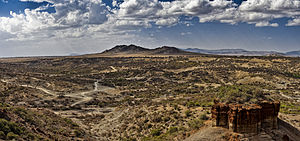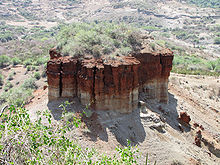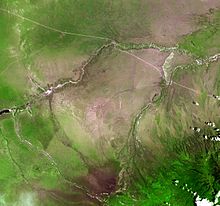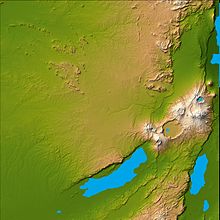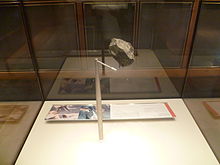- Olduvai Gorge
-
The Olduvai Gorge is a steep-sided ravine in the Great Rift Valley that stretches through eastern Africa. It is in the eastern Serengeti Plains in northern Tanzania and is about 48 km (30 mi) long. It is located 45 km from the Laetoli archaeological site. The gorge is an important prehistoric site, sometimes called "the Cradle of Mankind."
The name is a misspelling of Oldupai Gorge, which was adopted as the official name in 2005. Oldupai is the Maasai word for the wild sisal plant Sansevieria ehrenbergii, which grows in the gorge.
Contents
Geology and paleontology
Olduvai Gorge is one of the most important prehistoric sites in the world and has been instrumental in furthering understanding of early human evolution.
Chasing a fancy butterfly in the green wilds of Tanganyika 50 years ago, a German entomologist named (Wilhelm) Kattwinkel tumbled off a rocky ledge and nearly killed himself. When he regained his senses, he found himself in an anthropologist's dream world: an erosion-created rift with layer after layer of fossils, bones and ancient artifacts. The find was named Olduvai Gorge, and Kattwinkel's heirs ever since have been scrambling up and down its sun-baked sides in search of clues to man's earliest awakening. (Time, 10 March 1961)[1]
Virginia Morell (Ancestral Passions: The Leakey Family and the Quest for Humankind's Beginnings, 1995, Simon & Schuster, p. 57) treats this "tumbling story" as a tale. She writes: "Louis [Leakey] liked to depict Kattwinkel" as a nearsighted butterfly collector" who tumbled down. . . . He may not have lost his footing at the edge of the gorge [in 1911], but he did explore its eroded slopes and brought back a small collection of fossils."
Excavation work there was pioneered by Louis and Mary Leakey beginning in 1931 and continued into the 21st century by Professor Fidelis Masao of the Open University of Tanzania supported by Earthwatch; there have also been teams from Rutgers University. Millions of years ago, the site was that of a large lake, the shores of which were covered with successive deposits of volcanic ash. Around 500,000 years ago seismic activity diverted a nearby stream which began to cut down into the sediments, revealing seven main layers in the walls of the gorge. The geology of Olduvai Gorge and the surrounding region was studied in detail by Richard L. Hay,[2] who worked at the site between 1961 and 2002.
The stratigraphy is extremely deep and layers of volcanic ash and stones allow radiometric dating of the embedded artifacts, mostly through potassium-argon dating and Argon–argon dating. The base of the Olduvai sediments dates to slightly older than 2 million years,[3] with the first artifacts (pebble tools and choppers) appearing slightly above. Nearby site Laetoli has a much older fossil record.[4]
The earliest archaeological deposit, known as Bed I, has produced evidence of campsites and living floors along with stone tools made of flakes from local basalt and quartz. Since this is the site where these kinds of tools were first discovered, these tools are called Oldowan. It is now thought that the Oldowan toolmaking tradition started about 2.6 million years ago. Bones from this layer are not of modern humans but primitive hominid forms of Paranthropus boisei and the first discovered specimens of Homo habilis.
The site of Frida Leakey Korongo North (commonly known as FLK North and named after Louis Leakey's first wife) bears the distinction of having the oldest known evidence of Elephant consumption, attributed to Homo ergaster around 1.8 million years ago. A nearly complete skeleton of the extinct Elephas recki was found in the lowest of its six occupation levels along with stone tools such as choppers and flakes. Large numbers of bone fragments of smaller animals found with it clearly identify FLK North as an early butchering site.[5]
Above this, in Bed II, pebble tools begin to be replaced by more sophisticated handaxes of the Acheulean industry and made by H. ergaster. This layer has not yet been successfully dated, but likely falls between 1.75 and 1.2 million years.[6]
Beds III and IV have produced Acheulean tools and fossil bones from more than 600,000 years ago.
During a period of major faulting and volcanism roughly 400,000 to 600,000 years ago, the Masek Beds were made.
Beds above these contained tools from a Kenya-Capsian industry made by modern humans and are termed the Masek Beds (600,000 to 400,000 years ago), the Ndutu Beds (400,000 to 32,000 years ago), and the Naisiusiu Beds (22,000 to 15,000 years ago).
Also located on the rim of the Gorge is the Olduvai Gorge Museum. This Museum presents exhibitions pertaining to the Gorge's history.
See also
References
- ^ Science: Kattwinkel's Heirs. Time.com, Original article dated Friday 10 March 1961
- ^ Hay, Richard L. (1976) "Geology of the Olduvai Gorge." University of California Press, 203 pp.
- ^ Walter, R.C., Manega, P.C., Hay, R.L., 1992. Tephrochronology of Bed I, Olduvai Gorge: An application of the laser-fusion 40Ar/39Ar dating to calibrating biological and climatic change. Quaternary International 13-14, 37-46.
- ^ Drake, R., Curtis, G., 1987. K – Ar geochronology of the Laetoli fossil localities. In: Leakey, M.D., Harris, J.M. (Eds.), Laetoli: a Pliocene site in northern Tanzania, pp. 48-52. Claredon Press, Oxford.
- ^ Chazan, Michael: "World Prehistory and Archaeology, Pathways Through Time", Canadian ed., page 95. Pearson, 2008. ISBN 0-205-42665-4
- ^ McHenry, H.M., Brown, C.C., McHenry, L.J., 2007. Fossil hominin ulnae and the forelimb of Paranthropus. American Journal of Physical Anthropology 134: 209-218.
- Cole, Sonia (1975) Leakey’s Luck. Harcourt Brace Jovanvich, New York.
- Deocampo, Daniel M. (2004) "Authigenic clays in East Africa: Regional trends and paleolimnology at the Plio-Pleistocene boundary, Olduvai Gorge, Tanzania." Journal of Paleolimnology, vol. 31, p. 1-9.
- Deocampo, Daniel M., Blumenschine, R.J., and Ashley, G.M. (2002). "Freshwater wetland diagenesis and traces of early hominids in the lowermost Bed II (~1.8 myr) playa lake-margin at Olduvai Gorge, Tanzania." Quaternary Research, vol. 57, p. 271-281.
- Hay, Richard L. (1976) "Geology of the Olduvai Gorge." University of California Press, 203 pp.
- Joanne Christine Tactikos (2006) A landscape perspective on the Oldowan from Olduvai Gorge, Tanzania. ISBN 0-542-15698-9.
- Leakey, L.S.B. (1974) By the evidence: Memoirs 1932-1951. Harcourt Brace Jovanavich, New York, ISBN 0-15-149454-1.
- Leakey, M.D. (1971) Olduvai Gorge: Excavations in beds I & II 1960–1963. Cambridge University Press, Cambridge.
- Leakey, M.D. (1984) Disclosing the past. Doubleday & Co., New York, ISBN 0-385-18961-3.
External links
Categories:- Landforms of Tanzania
- Archaeological sites in Tanzania
- Paleoanthropological sites
- Pleistocene paleontological sites of Africa
- Prehistoric Africa
- Geology of Tanzania
Wikimedia Foundation. 2010.

